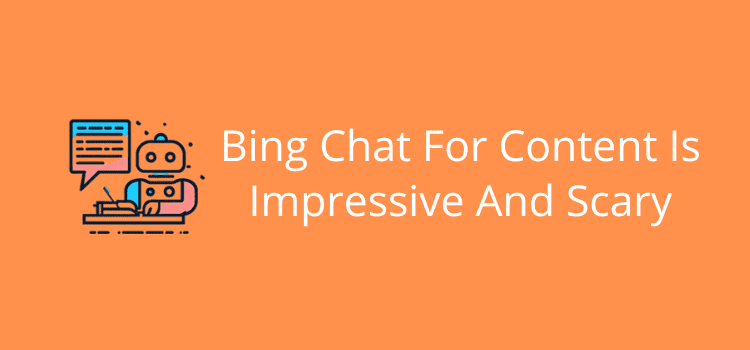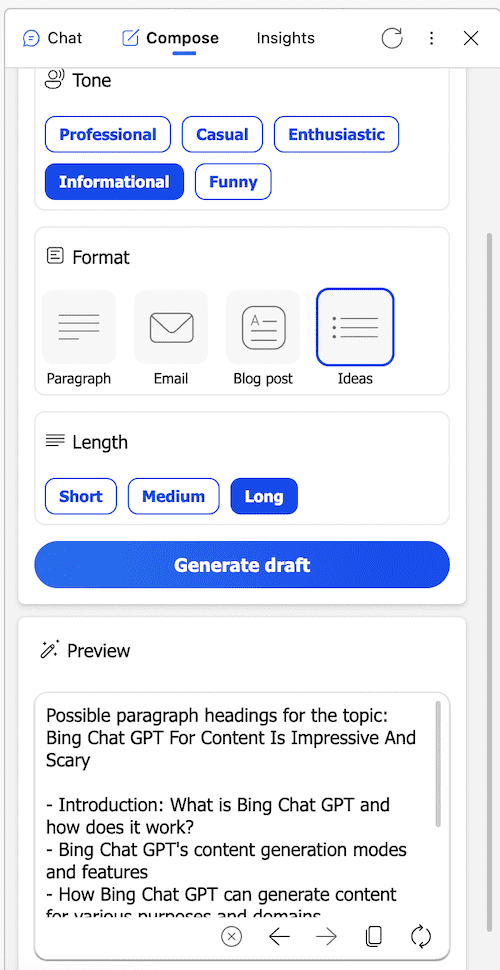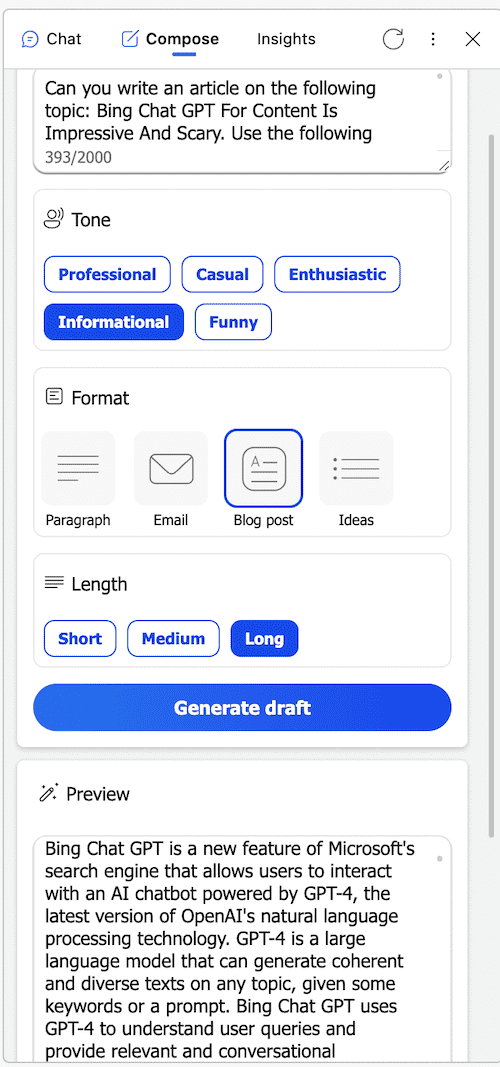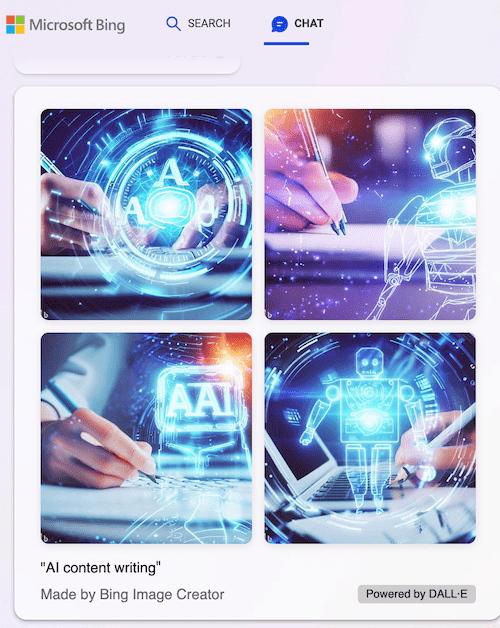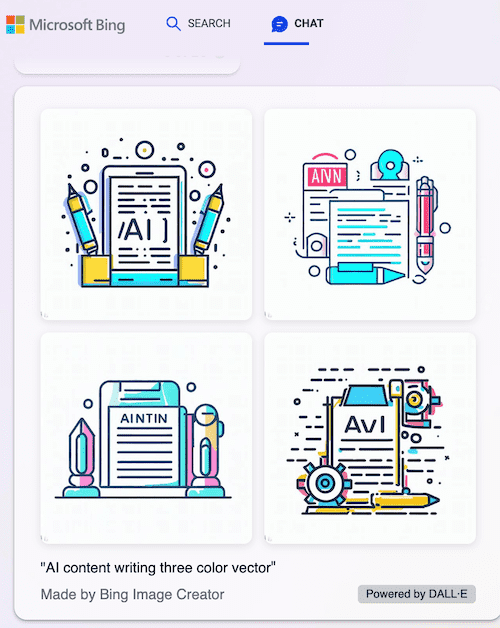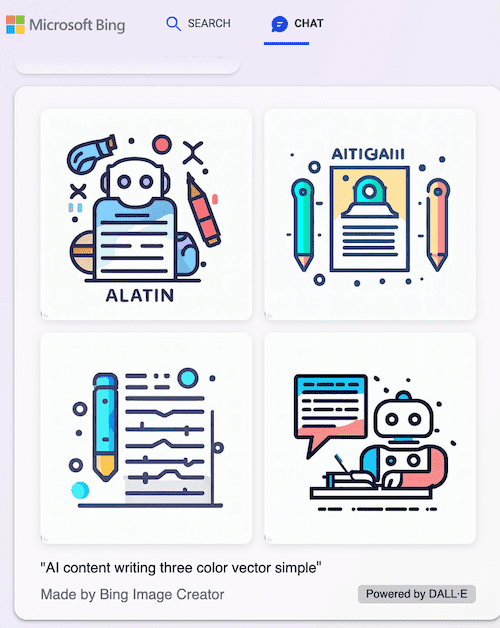As a writer, I know AI (artificial intelligence) is the inevitable future. But Bing Chat content creation is not the future; it’s the present.
While I have many reservations and concerns, there is no point in burying my head in the sand.
I hesitated, but because the tools are so easily accessible now, I had to see what they could do.
The results were both fantastic and frightening.
How to start using Bing Chat
The first thing to know is that you can only access all the tools using the Microsoft Edge browser with Bing Search.
If you don’t have Edge, you will need to install it. It’s available for Mac as well as PC.
When you open Bing Search, there are two links to open the AI tools.
At the top, on the left, is a menu link, “Chat.” Here you can ask questions or start a creative.
The other link is in the very top right corner of the browser. It is a small blue and green Bing logo.
With this link, you open the Composer, where you can generate ideas, headings, or short, medium, or long texts.
As I quickly discovered, both interfaces are easy and intuitive to use.
Like you probably, I have experimented with the free version of ChatGPT. But to be honest, Bing leaves it for toast.
The information is much more up-to-date and can provide links and citations.
But the most significant difference is that Bing can produce AI images in seconds.
My quick experiment
Even if I believe AI poses a threat to writers, the only way to find out what it can do is to try it.
So I set about creating an article with the help of Bing.
But what topic should I select?
I decided that Bing Chat was the obvious topic because that was what I was investigating.
My starting point was in the Composer.
I selected the “Ideas” button, and my prompt asked for paragraph heading ideas.
You can see the settings I used in the image below.
My next step was to use the list of ideas in my prompt to generate an article text.
I selected “Blog Post,” “Informational,” and “Long.”
My prompt included the instruction to use the headings from my previous result.
The result was a text of a little over 800 words.
Image creation
My last step was to create an image for the article.
You can do this from the “Chat” link.
My prompt was; Create an image of the topic of AI content writing.
Here’s the first result.
But I would prefer a vector image. So I changed my prompt and asked for a three-color vector.
But I wanted a simpler version, and there was even a pre-applied prompt to do this.
So now I had my text and images.
What next?
Using the output
My first step was to check the text with Grammarly.
That’s ironic, in a way, getting AI to check AI.
But most writers are comfortable using tools like Grammarly, which says we have happily adopted AI in certain forms.
Grammarly only suggested a few possible edits, but none were critical.
It also came back with a 99% clean score for plagiarism.
But in my view, the text contained too many repetitions, a few contradictions and was a little difficult to read.
Yes, I could have gone back and asked for a rewrite in the first or second-person point of view or a lighter tone.
But for the sake of my experiment, I worked with the original version.
I went to work on some minor editing of the text, but trying to stay with the tone of the output. However, editing the text took me quite some time until I was reasonably happy.
My last step was to use one of the generated vector images in the header image for this article.
So what was the result?
A Bing Chat article
The following part of this article was produced with the assistance of Bing Chat.
It is based on AI-generated text with corrections and editing.
What is Bing Chat, and how does it work?
Bing Chat is a new feature of Microsoft’s search engine that allows users to interact with an AI chatbot powered by GPT-4, the latest version of OpenAI’s natural language processing technology.
It is a large language model that can generate coherent and diverse texts on any topic, given some keywords or a prompt.
Bing Chat uses GPT-4 to understand user queries, provide relevant and conversational responses, and generate content for various purposes and domains.
Content generation modes and features
Bing Chat has three content generation modes: More Creative, More Balanced, and More Precise.
Users can choose the mode that suits their needs and preferences, depending on the type and tone of the content they want to create.
For example, the More Creative mode can generate imaginative and original texts, such as stories, poems, or images.
In contrast, the More Precise mode can generate factual and informative texts, such as summaries, reports, or essays.
It also has some features that enhance the content generation experience.
Users can request citations for the facts and sources the chatbot uses and real-time information from the web or give feedback to the chatbot and help it improve its responses and content quality.
Generating content for various purposes and domains
Bing Chat can generate content for various purposes and domains, such as education, entertainment, business, or personal use.
Users can ask the chatbot to write an article, a blog post, a review, a resume, a cover letter, a speech, a script, a tweet, a caption, a slogan, a headline, a joke, a riddle, a trivia question, a crossword clue, a recipe, a horoscope, a playlist, a haiku, a limerick, a sonnet, a rap song, a parody song, a meme, a comic strip, a logo design, a portrait sketch, a landscape painting, a collage art, or anything else they can think of.
The benefits and challenges
There are many benefits for people who want to create content at scale.
It can save time for writers by generating texts on demand and inspiring creativity by offering new ideas and perspectives.
There is the possibility to enhance learning by providing information and explanations or entertaining by generating fun and engaging texts.
However, it also has some challenges that users must be aware of.
AI can generate inaccurate or misleading texts that may not reflect reality or truth.
It can also generate inappropriate or harmful texts that may offend or hurt someone. It can generate plagiarized or copyrighted texts that may violate intellectual property rights.
There is additionally the possibility that it can generate biased or manipulative texts that may influence someone’s opinions or actions.
The ethical and social implications
There are many questions about the responsibility and accountability of the chatbot and its creators for the content it generates.
This raises questions about the privacy and security of the user data and the chatbot data that are collected and stored.
Other difficult questions are about the impact of the chatbot on human communication and interaction.
These issues raise questions about the potential of the chatbot for good or evil.
How to use Bing Chat GPT responsibly and safely
Bing Chat is an amazing tool that can help users create content for various purposes and domains.
However, it is certainly not perfect and is definitely not human. Users need to use it responsibly and safely by following some guidelines.
It is for personal or educational purposes only. Do not use it for commercial or professional purposes without proper attribution and permission.
Apply critical thinking and common sense. Do not trust or accept everything it generates. Verify the facts and sources it provides, and check the quality and originality of its texts.
Threat it with respect and kindness. Do not abuse or harass it or anyone else with its texts. Avoid generating texts that are hateful, harmful, illegal, or unethical.
Use it with caution and moderation. Do not rely on it too much or too often.
Balance your use with your own creativity and expression.
End Of Bing Chat Generated Text
Analysis of the text
The original text output for the section above was 820 words.
However, it contained multiple occurrences of four or five consecutive sentences starting with the same word.
Another issue was the number of excessively long sentences. I removed or edited many.
But I decided to retain one describing what you can ask the chatbot to produce purely as an example of the poor writing quality it produced.
Another issue was contradictions. As you can see in the text above, it boasts of what you can do but then later warns against doing so.
It was also noticeable that the content for each heading seemed to change the tone and substance.
The fact that the text is produced, copied, or (stolen) from multiple pieces of online content is presumably the cause of these inconsistencies.
In the end, I trimmed the text down to a little over 600 words.
However, the time it took me to edit and correct the text was probably more than if I had researched and written 600 words myself.
Summary
In total, my quick experiment took me about seven hours. But without a doubt, had I wanted to, I could have produced a readable text in less than twenty minutes.
That is where the capabilities of AI are both extremely powerful and frightening.
My main concern is that it is possible to output and publish reasonable content on such a scale that it will pollute online content.
Google has said that 60% of content on the Internet is duplicate.
AI is a misnomer because it is only intelligent from the perspective of collecting and using published online content and spinning it together to avoid plagiarism.
At least when people blatantly copy and republish my articles, I can track them down. But with AI, I have no way of knowing if it steals and uses my writing.
If you are a content writer like me, you’ll know how difficult it has become to rank for articles on Google and Bing.
This will only make it harder, even if search engines say they are smart and can differentiate. As yet, I haven’t seen any proof of this ability.
Yes, there is some clearly marked generated content in this article. But I used it to give you an example of its abilities.
However, I wrote most of this article the old-fashioned way. One word at a time from my knowledge and imagination.
What do I think about Bing Chat?
It’s here now, so people will undoubtedly use it.
But for me, AI text generation is still not up to the standard that a competent writer can produce. I might use it occasionally for ideas, but that’s about it.
However, the image creation tool is pretty cool, so I might use it occasionally.
As to the future of writing and publishing and AI, the following phrase comes to my mind.
Danger, Danger, Will Robinson!
Related Reading: ChatGPT Authors Start An Ebook Frenzy On Amazon
The post Bing Chat Content Creation Is Amazing And Scary appeared first on Just Publishing Advice For Writers and Authors.
Go to Source
Author: Derek Haines
